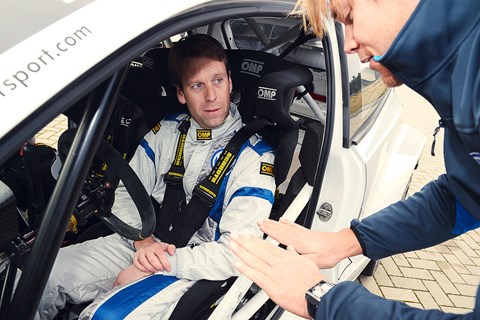► What’s it like to drive a full-on WRC car?
► CAR borrows Andreas Mikkelsen’s wheels
► We test the Volkswagen Polo WRC
I must’ve traded places with cartoon character Mr Benn. One minute I’m walking into a tent wearing civvies, the next I emerge into a parallel universe. I’m at VW’s Ehra- Lessien test track, dressed as a Volkswagen world rally driver. Ahead of me sits a Polo WRC, and look, there’s WRC driver Andreas Mikkelsen; he’s holding the driver’s door, beckoning me to climb inside. Surely this isn’t happening.
The Polo R WRC is the world’s best rally car, with two manufacturers’ and drivers’ titles from two years’ competition. The most skilful rally drivers in the world would form a long and disorderly queue to drive it. Today, somehow, I’m given that opportunity. Prior experience? I watch WRC on the telly when I can, once completed the snowy bit on Sega Rally and have driven the Skoda Fabia S2000 – the basis for Polo development – but that’s it. I realise that lots of people hate me.
I snag my foot on the criss-cross of the rollcage, bang my helmeted head on the roof and freefall into a bucket seat that feels mounted direct to the road. Padding is removed from the seat-back so my legs can comfortably operate the pedals, the four-point harnesses are pulled tightly over my shoulders and around my waist, and the combination of HANS device and wraparound head restraint gives shire-horse vision.
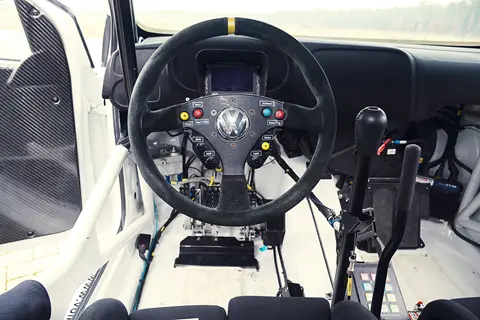
This is not grandma’s Polo. The carpets, the stereo, even the boiled sweets have been removed to leave a bare and almost industrial environment. There are exposed mechanisms, braided hoses and a pair of long levers that look lifted from a JCB; that’s the gearlever and handbrake.
‘You wouldn’t believe the speed that I see that handbrake used in,’ says Richard Browne, Mikkelsen’s engineer. ‘You see the onboards and the telemetry and they’ve been pulling it in fifth, maybe just to correct the front end a little.’
Ah yes, telemetry. Mikkelsen has already laid down a 1.14:034 over 1.8 greasily damp kilometres, which alternate between technical second-gear sections, major on the third-gear stuff, and occasionally stray into sixth-gear madness. My efforts will be recorded and overlaid alongside Mikkelsen’s; the cold wind of hard data blasts through the cabin.
For all its intent, the Polo remains an unintimidating car to approach because it’s so tiny, but that changes with a press of a small red button on its suede- wrapped steering wheel. The 1.6-litre turbocharged engine fires up with the deep, bassy bwwwrrrrrrrr that defines the modern WRC car; it vibrates your entire body like a tuning fork.
Dip the clutch, push forward the large gearlever and first gear flashes up on the digital tacho. I know the clutch – used for stopping and starting – will fire my foot off like an elephant flipping a mouse off a seesaw, so I concentrate intently on holding the revs at 3000rpm and easing it up; I smooth a couple of hiccoughs and kangaroo lightly away, early humiliation averted.
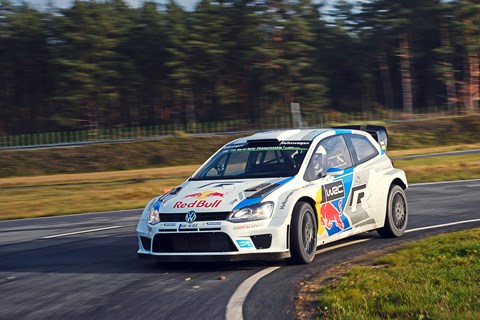
I’ve got four laps: out- and in-laps in Road mode, plus two fast laps in full- bore Stage mode. Early impressions? The pedals are laid out for left-foot braking, but while I can do that to a certain level, I can’t do it at maximum attack. You sit low down and the rollcage is quite bulky, so you can’t actually see the corners of the car, but it’s testament to the Polo’s user- friendliness that I feel at ease.
Towards the end of the familiarisation lap I press Stage mode and the Polo snaps to attention, its engine gruffer and louder, the throttle more hair-trigger, the gear indicator on the dash now much more dominant; I gulp and press the throttle hard.
The Polo might have a little over 300bhp, small-fry these days, but the raw figures don’t articulate the ballistic delivery; I can’t detect any turbo lag, and a rush of torque catapults the car forwards in a bluster of gear whine, exhaust boom and road noise. I don’t have the mental slack to monitor the pyramid gear-shift lights, so I change gear when it feels right, which is every second thanks to the closely stacked cogs.
The first section of track is pretty technical, which reins in the speed; the highlight is a slightly downhill right that sucks you in to a compression, then quickly rides the topography back uphill while tightening. It’d be easy to go off if you were greedy with your entry speed in these damp conditions. I turn in on the brakes, and the super-quick steering lends a scrum-half agility to direction changes, exaggerating just how short the Polo is.
The Polo might be all-wheel drive, but it’s got an incredibly adjustable balance and you have to add steering corrections in double-quick time. On the plunge downhill, the rear of the car starts to slide; my hands blur to get the steering lock on and off again, then I flatten the throttle and ride that kerb as the road rises back uphill. This car is wired and I feel like yeehawing until my lungs explode.
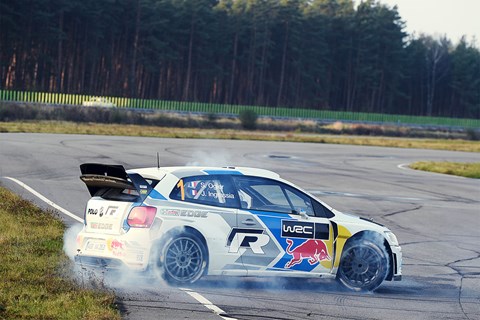
The next section of track eases a little, so I keep the throttle pinned, pulling for gears like I’m firing mortars; speed violently snowballs. There’s a little kink that’s only partially visiblethrough the scraggy grass at the track edge, so I lift a little, cursing myself immediately when I see that it was flat-out, but still, I’m up into sixth gear. Flat-out in sixth gear in a WRC car! This feels amazing!
The road again bucks and weaves, but this time it’s faster, and the Polo reveals more of its chassis balance; active diffs are now banned from the WRC, so the all-wheel-drive system has a constant 50/50 split. This can give quite pronounced understeer, and I feel the nose pushing wide with the Polo still gathering huge speed over a crest. Handbrake? Best not.
No sooner are we pointing straight than a huge stop looms ahead of a tight left turn. There is no ABS for the Alcon brakes, it’s damp, I can see thick skid marks on the road… I leave it as late as I think sensible, then squeeze onto the brake pedal progressively but firmly. I feel the pressure building under my foot, a huge, reassuring ball of meaty goodness with easy feel and modulation. These are monster stoppers, and the car hauls up like a dog running out of lead.
All the while I’m learning more about this amazing car: that it’ll sometimes spit into oversteer exiting the slow stuff, that it’s often determined to understeer on a constant throttle and that you really do have to pull that gear lever hard. It’s the thing I focus least on, a couple of fluffed changes the inevitable result.
After four laps it’s all over, and I’m so excited I want to jump on the roof and inappropriately spray champagne at bystanders; I’ve driven a WRC quite quickly without crashing!
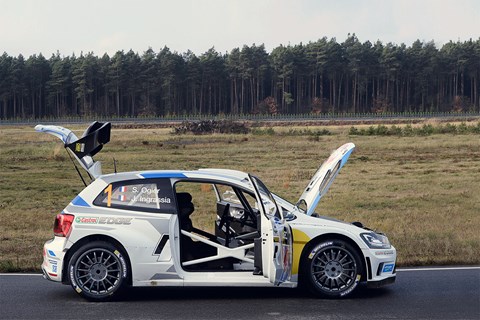
But then comes the other kind of crash: the back-to-earth kind. It’s normal with these opportunities for the pro to give you a passenger ride after your effort; that way you don’t get any big ideas and dispatch his car to the great finish line in the sky. So Mikkelsen invites me to the co-driver’s seat.
It’s a predictably amazing experience. Mikkelsen’s obviously just miles faster than me, but he’s much more aggressive as he bullies the car into corners, stays flat on the accelerator through the fast sections where I hesitated, and brakes later and with much more force. He also uses the brakes to play with the car’s balance; so where I was cautious through a tightening corner because I could feel the onset of understeer, Mikkelsen uses a sharp stab on the brakes and a bung of steering to neutralise it and point the nose at the apex.
I’m already crushed when I climb out, but Browne is on hand with the telemetry to deliver the killer blow. Can you cut me some slack here? I’d driven the track twice before my laps in the Polo WRC, and I got two runs; the process of bonding with car and track has nowhere near settled down by then. Okay. The telemetry.
It looks much like the ECG of a healthy heartbeat overlaid with someone in cardiac arrest being jump- started on a defibrillator. I can immediately see there are some commonalities, that I was accelerating and braking in largely similar places, but I say that with the very broadest brush strokes; sometimes Mikkelsen is flat-out and I’m not even touching the pedal. But there are positives too: my little confidence-lifts don’t actually impact much on my speed, and Browne says I’m clearly taking the correct lines and accelerating in the right places with a measured progression.
There’s even one section where I’m faster than Mikkelsen, a tiny little blip where my white line strains above his red one. Browne says something about compromising my exit speed for a long straight where Mikkelsen monsters me, but I’m too busy looking at that little spike of white to take it in, you know, taking the positives forward for next year.
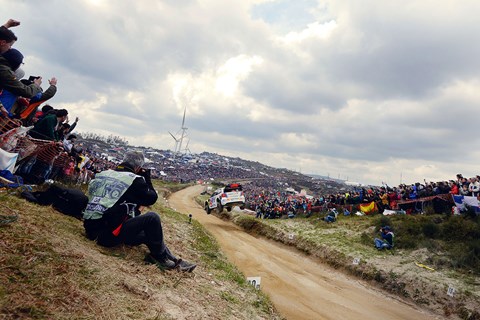
Really, though, there are three key areas where Mikkelsen destroys me: the very fastest bits that I hadn’t yet committed to memory (nothing to do with balls, honestly); the technical bits where he’d killed the understeer and made the car dance; and the fact that he’s braking so much later than me. There’s a bit in the data that shows Mikkelsen waiting a full 60 metres longer, then using 40-bar pressure to my 25.
The initial results have me doing a 1:20.506, then slipping to a 1:22.312, my best almost 6.5sec behind Mikkelsen’s 1:14.034. This much slower second lap confuses me because the laps felt similar, but then I realise we were told to slow to avoid crashing into the Mr Benn tent. Later, I obsessively go back over the data, removing that section. That yields a 1.09:49 followed by an improved 1.09.29, with Mikkelsen dropping from a 1.04.94 to a 1.03:24 over more laps.
I still can’t make the data lie about the gulf between Mikkelsen and I, but Browne is an avuncular character, and the night before I’d heard him talking, full of hard data and lost tenths, yes, but also encouraging and motivating. I feel this as he talks through my run. We’re both confident that I’d have carried more speed as I became more comfortable with the quickest sections, and I think I’d have got more proactive at making the car dance around to cancel understeer.
But the most valuable lesson Mikkelsen and Browne teach me today is the braking. It might sound obvious, but it’s not only my braking later that’d help, it’s doing it with much more pressure, so that I still end up at the apex with the car under the same control.
As I change back into my journalist’s uniform, it’s impossible not to appreciate the opportunity I’ve been gifted today. Then one of the PRs underlines it. ‘You know,’ he says, ‘someone from Kazakhstan asked to buy a Polo WRC recently. Money was no object, even a few million Euro, but Volkswagen said no.’
I might be deflated, but I know it’s not only a Kazakhstanian playboy who hates me right now.
